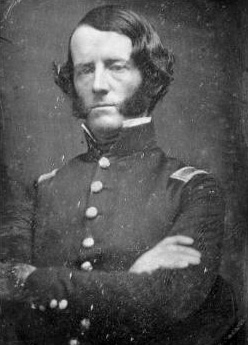Carter L. Stevenson facts for kids
Quick facts for kids
Carter Littlepage Stevenson
|
|
|---|---|
 |
|
| Born | September 21, 1817 Fredericksburg, Virginia |
| Died | August 15, 1888 (aged 70) Caroline County, Virginia |
| Place of burial |
Confederate Cemetery, Fredericksburg, Virginia
|
| Allegiance | |
| Service/ |
|
| Years of service | 1838–61 (U.S.A), 1861–65 (C.S.A) |
| Rank | |
| Battles/wars | Second Seminole War Mexican-American War -Battle of Palo Alto - Battle of Resaca de la Palma Third Seminole War Utah War American Civil War - Battle of Perryville - Battle of Champion's Hill - Siege of Vicksburg - Atlanta Campaign - Battle of Nashville - Carolinas Campaign |
Carter Littlepage Stevenson, Jr. (born September 21, 1817 – died August 15, 1888) was an important military officer. He served in the United States Army before the American Civil War. Later, he became a general in the Confederate States Army during the Civil War.
After the war, Stevenson worked as an engineer. He designed and built things like roads and mines. He passed away in Caroline County, Virginia, and was buried in Fredericksburg. In 1914, a special statue (a marble bust) was made to honor him at the Vicksburg National Military Park.
Early Life and Military Start
Stevenson was born in Fredericksburg, Virginia. His family was well-known in the area. He went to the United States Military Academy at West Point, a famous military school. He graduated in 1838.
After West Point, he became a second lieutenant in the army. He was sent to Wisconsin. Two years later, he became a first lieutenant. He fought in the Second Seminole War in Florida. In 1842, he married Martha Silvery Griswold. They had four children.
Stevenson then moved to Texas. He served on the frontier, which means he helped protect the border. He fought in the Mexican–American War. He showed bravery in battles like Palo Alto and Resaca de la Palma. After the war, he served in places like Mississippi and Indian Territory. He also helped explore routes for a railroad across the country. During this time, he sometimes had small fights with Apache Native Americans.
From 1856 to 1857, Stevenson fought again in Florida. This was during the Third Seminole War. He took part in battles at Big Cypress Swamp and Bowleytown. He then went west again and fought in the Utah War. While in Utah Territory, he joined a group called the Freemasons. He continued his regular army duties until 1861.
Serving in the Civil War
When the Civil War began in 1861, Stevenson returned to Virginia. Virginia had left the Union to join the Confederacy. He offered his skills to the Confederate army. He quickly rose in rank, becoming a lieutenant colonel and then a colonel. He commanded a Virginia infantry unit.
In February 1862, Stevenson was promoted to brigadier general. He was first assigned to guard a railroad in Virginia. Soon after, he was sent to Tennessee to lead a large group of soldiers called a division.
When Union forces took the Cumberland Gap, Stevenson led his Confederate troops to victory. He captured the Union soldiers at Munfordville, Kentucky. This forced General George W. Morgan to retreat. Stevenson's division then helped chase Union forces into Kentucky. He joined forces with General Edmund Kirby Smith. For his strong leadership, Stevenson was promoted to major general in October 1862. He led his division in the Battle of Perryville.
In December, General Braxton Bragg sent Stevenson and 10,000 men to help General John C. Pemberton. Pemberton's forces were at Vicksburg, Mississippi, and were being threatened by Union General Ulysses S. Grant. Stevenson's division faced the main attack at the Battle of Champion Hill. His 6,500 men bravely fought against nearly 25,000 Union troops. After a tough fight, Stevenson's lines had to pull back.
When Pemberton's army was defeated at the Battle of Big Black River Bridge, Stevenson led the retreating soldiers. General Pemberton rushed to Vicksburg to prepare the city's defenses. During the Siege of Vicksburg, Stevenson commanded the right side of the Confederate defense line. When Pemberton surrendered his army on July 4, 1863, Stevenson became a prisoner of war. However, he was soon released on parole, meaning he promised not to fight again until exchanged.
General Stevenson then joined the Army of Tennessee in Chattanooga, Tennessee. He was given command of a division under General William J. Hardee. His division guarded Lookout Mountain. After the Battle of Lookout Mountain, he pulled his troops back. He destroyed bridges to slow down the Union army led by General Joseph Hooker. He then helped strengthen the main Confederate line at the Battle of Chattanooga.
During the 1864 Atlanta Campaign, Stevenson's division was part of General John Bell Hood's corps. They fought in battles around Atlanta, including Resaca, Kennesaw Mountain, and Peachtree Creek. When General Hood took command of the army, Stevenson temporarily led Hood's corps.
In the Tennessee Campaign, Stevenson commanded a division at the Battle of Nashville. When General Stephen D. Lee was injured, Stevenson took charge of organizing the retreat. His division had lost many soldiers and couldn't get many new ones. With only about 2,600 men left, his division fought in the Carolinas Campaign against Union General William T. Sherman. This included the Battle of Bentonville. For the second time in the war, Stevenson surrendered to the Union forces. This happened when General Joseph E. Johnston surrendered his army to Sherman in April 1865. Stevenson was again released on parole and sent home.
Life After the War
After the Civil War ended, Carter L. Stevenson became a civil and mining engineer. He worked in this field until he passed away in Caroline County, Virginia, on August 15, 1888. He was buried in the Confederate Cemetery in Fredericksburg.
In 1914, a special marble statue was placed at the Vicksburg National Military Park to honor Major General Carter L. Stevenson.
Images for kids


